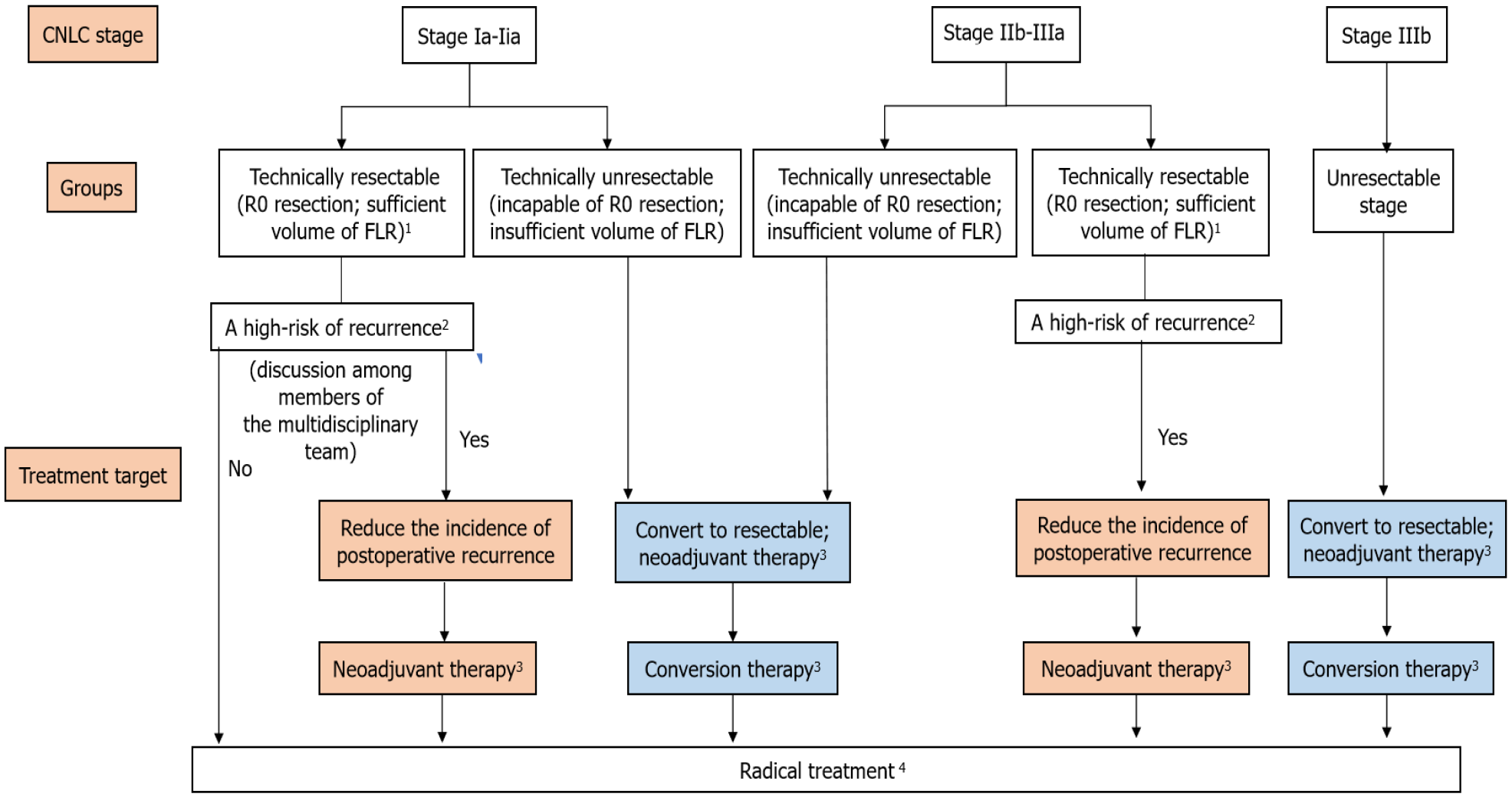Copyright
©The Author(s) 2021.
World J Gastroenterol. Dec 21, 2021; 27(47): 8069-8080
Published online Dec 21, 2021. doi: 10.3748/wjg.v27.i47.8069
Published online Dec 21, 2021. doi: 10.3748/wjg.v27.i47.8069
Figure 1 Algorithm of neoadjuvant and conversion therapies for liver cancer.
1Technically resectable criteria: R0 resection, sufficient volume of the future liver remnant, Child-Pugh class A/B (some patients)[1]. 2Comprehensive evaluation by preoperative imaging examination findings and serum levels of biomarkers should be performed to assess the risk of postoperative recurrence[44]. Postoperative recurrence risk factors: (1) For patients with stage Ia, Ib, and IIa liver cancer, unclear tumor boundary, closely adjacent of the tumor to blood vessels, and highly suspicious residual tumors are among the high-risk factors of recurrence; (2) For patients with stage IIb-IIIa liver cancer, the high-risk factors of recurrence include the number of tumors ≥ 3, tumor diameter > 5 cm, satellite nodules, macroscopic cancer emboli, microvascular invasion-positive, lymph node metastasis, invasion of adjacent organs, and high alpha-fetoprotein level before surgery[13,44]; and (3) Other recurrence factors include liver diseases (e.g., viral hepatitis and liver cirrhosis)[13]. 3(1) Stage Ia-IIa: Neoadjuvant therapy is not recommended in clinical practice; if the multidisciplinary treatment clarifies the high risk of postoperative recurrence, neoadjuvant therapy can be performed in clinical trials after ethical approval; (2) Stage IIb-IIIa: Radical treatment following neoadjuvant therapy is recommended for patients with technically resectable liver cancer and high risk of recurrence, aiming to reduce the postoperative recurrence; and (3) For patients with unresectable liver cancer who are incapable of R0 resection or insufficient volume of future liver remnant (FLR), conversion therapy can be conducted to eliminate unresectable hepatic tumors. 4Radical therapies, including liver transplantation, resection, and radiofrequency ablation, are highly appropriate for early-stage liver cancer patients. Liver transplantation: Patients who meet the Milan criteria or the University of California San Francisco (UCSF) criteria after preoperative treatment can be treated with liver transplantation. (1) Milan criteria: Diameter of a single tumor ≤ 5 cm, the number of tumors ≤ 3, in which the diameter of the largest tumor was ≤ 3 cm, and without large blood vessel or lymph node invasion; and (2) The University of California San Francisco criteria: Diameter of a single tumor is ≤ 6.5 cm, the number of tumors ≤ 3, in which the diameter of the largest tumor was ≤ 4.5 cm, and the sum of diameters of all tumors was ≤ 8.0 cm, without a large blood vessel or lymph node invasion[7]. Radiofrequency ablation: Patients reached China Liver Cancer (CNLC) stage Ia or Ib (e.g., a single tumor, the diameter of tumor ≤ 5 cm; or with 2-3 tumors, in which the largest diameter was ≤ 3 cm) after preoperative therapy or without blood vessel, bile duct, and adjacent organ invasion, without distal metastasis, and liver function of Child-Pugh class A/B could be treated by radiofrequency ablation, which can also achieve the effects of radical treatment[7].
- Citation: Zhao HT, Cai JQ. Chinese expert consensus on neoadjuvant and conversion therapies for hepatocellular carcinoma. World J Gastroenterol 2021; 27(47): 8069-8080
- URL: https://www.wjgnet.com/1007-9327/full/v27/i47/8069.htm
- DOI: https://dx.doi.org/10.3748/wjg.v27.i47.8069









